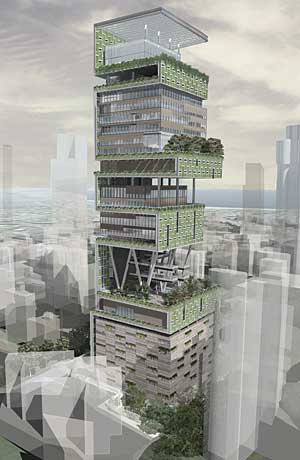 I recently learned about the Antilia building, which is under construction in Mumbai, by Perkins + Will, for Indian tycoon Mukesh Ambani. A couple of descriptive paragraphs:
I recently learned about the Antilia building, which is under construction in Mumbai, by Perkins + Will, for Indian tycoon Mukesh Ambani. A couple of descriptive paragraphs:Construction is underway, albeit with some delays, on one of India’s highest profile and most opulent projects—the Antilia, a 490-foot-tall corporate meeting facility and private residence in Mumbai. Chicago-based Perkins + Will designed the 24-story tower for business tycoon Mukesh Ambani, whose family will occupy roughly 35,000 square feet in its top floors.
Among its interesting elements, Antilia will feature a band of vertical and horizontal gardens that demarcates the tower’s different program elements. A garden level will separate the ground-floor parking and conference center from residential space above, for instance, and the outer walls on certain levels will be sheltered by trellises supporting panels that contain hydroponically grown plants.In addition to signaling different space uses and providing privacy, these “vertical gardens” will help shade the building and reduce the urban heat island effect. “You can use the whole wall almost like a tree and increase the green area of the site by five or 10 times over what it would be if you just did a green roof,” Johnson observers. “It’s a prototype for buildings of the future.”
Oh, wow. What a crazy building, and while some of the architectural and green design aspects are interesting, it is difficult to see how this building either fits in with the development needs of Mumbai, in general, or a commitment to green design. I guess the rich get what they want, although if this building is a prototype for the future, it seems we're moving ever-closer to a Blader Runner-like dystopia, where the rich live comfortable lives in high-rises towering above the city floor, while discharging a disproportionate amount of waste to and depleting resources from those stuck on the ground, in the shadows below.
The Slate.com article which brought this building to my attention is interesting, as well, in dissecting how efforts to create standards for certifying green building design (specifically, the LEED certification standards) can be counter-productive for really achieving green design objectives. The main criticisms seem to be that LEED's check-list based system for evaluating building design give similar weight to disproportionate investments in green design, creating mis-aligned incentives, that the checklist oversimplifies many of the design objectives and fails to create baseline standards, and that the premium is placed on achieving efficiency and not on controlling scale.
I haven't really paid attention to the evolution of LEED in ten years, but the criticisms seem like pretty standard fare for most initiatives trying to bring standards for sustainability into commercially-driven enterprises. I don't disagree with any of Daniel Brook's analysis of LEED (to the extent that I am familiar with the standards and qualified to agree or disagree), but also it bears mention how difficult it is to create initiatives that both achieve sustainable objectives and will gain buy-in from the companies that need to be properly incentivized and to implement designs and programs according to those standards. Not an excuse, just highlighting the ongoing design challenge that people serious about sustainability will continue to face.
The Slate.com article which brought this building to my attention is interesting, as well, in dissecting how efforts to create standards for certifying green building design (specifically, the LEED certification standards) can be counter-productive for really achieving green design objectives. The main criticisms seem to be that LEED's check-list based system for evaluating building design give similar weight to disproportionate investments in green design, creating mis-aligned incentives, that the checklist oversimplifies many of the design objectives and fails to create baseline standards, and that the premium is placed on achieving efficiency and not on controlling scale.
I haven't really paid attention to the evolution of LEED in ten years, but the criticisms seem like pretty standard fare for most initiatives trying to bring standards for sustainability into commercially-driven enterprises. I don't disagree with any of Daniel Brook's analysis of LEED (to the extent that I am familiar with the standards and qualified to agree or disagree), but also it bears mention how difficult it is to create initiatives that both achieve sustainable objectives and will gain buy-in from the companies that need to be properly incentivized and to implement designs and programs according to those standards. Not an excuse, just highlighting the ongoing design challenge that people serious about sustainability will continue to face.
No comments:
Post a Comment